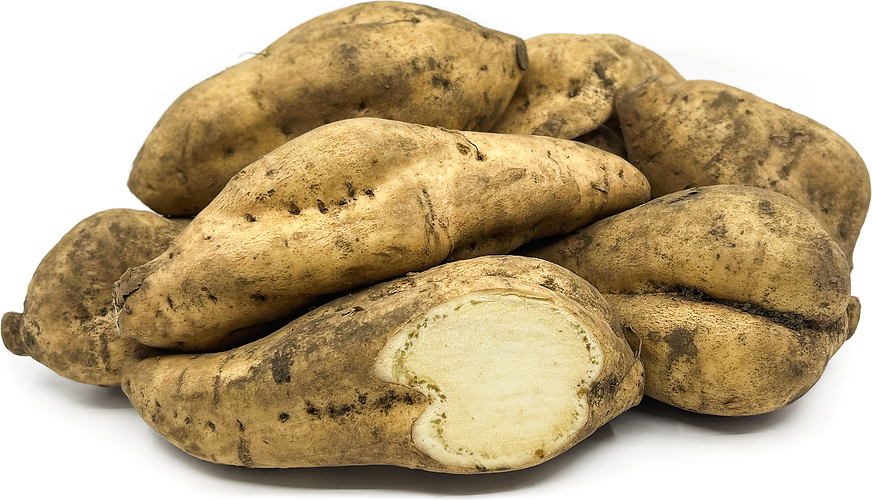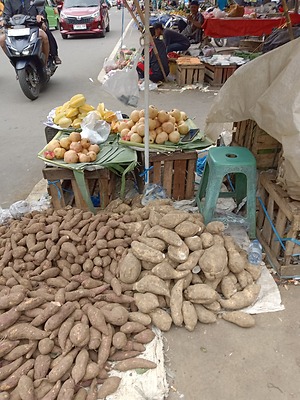


Kogane Sengan Sweet Potatoes
Estimated Inventory, lb : 0
Description/Taste
Kogane Sengan sweet potatoes are a high-starch Japanese sweet potato. They have a similar shape to orange yams as they are tapered at both ends and are largest in the middle. Their skin has a tan, golden-brown hue with darker brown spots speckled throughout, similar to the appearance of a Russett potato. The skin's outer texture is rough and dry to the touch. When sliced open, the sweet potatoes’ flesh has a white-yellow hue and a firm, mealy texture. When this variety is heated, its flesh becomes fluffy, light, and powdery. The Kogane Sengan sweet potato has moderate sugar levels, lower than that of other varieties but still sweeter than most vegetables.
Seasons/Availability
Kogane Sengan sweet potatoes are available from fall to winter.
Current Facts
The botanical name for Kogane Sengan sweet potatoes is Ipomoea batatas and they are from the Convolvulaceae family. In Japan, sweet potatoes are called Satsuma Imo or Kara Imo. This varieties’ high starch content makes them a suitable ingredient for Shochu, a popular Japanese spirit. Japan has over 50 different varieties of sweet potato, including the Beni Azuma, Anno Imo, Beni Haruka, Naruto-kintoki, Ayamurasaki, and Ayakomachi. In this country, sweet potatoes are available year-round and are often used as an additive to natural sweeteners, processed snacks, adhesives, dentifrices, and medicines. Unlike the Kogane Sengan variety, most sweet potatoes in Japan have purple skin.
Nutritional Value
Kogane Sengan sweet potatoes contain vitamins C and E, which aid in immune support and protect against oxidative stress. They are a good source of potassium, regulating fluid balance, nerve signals, and muscle contractions. The high fiber content in this variety supports digestive health and promotes feelings of fullness. These sweet potatoes provide the body with anthocyanins, a potent antioxidant with anti-inflammatory and anti-cancer properties. Kogane Sengan sweet potatoes release a white liquid called yarapin, which has been recognized for its ability to promote skin turnover and its mild laxative effects that may further support digestion.
Applications
Kogane Sengan sweet potatoes cannot be eaten raw but may be baked, boiled, or fried. When fried, they can be used to make tempura, cut up into strips for crispy sweet potato fries, or stir-fried with vegetables, garlic, sesame oil, and proteins like pork or chicken. This variety can be incorporated into soups like niku-jyaga, a Japanese stew made with beef and potatoes. The sweet flavor of these potatoes allow them to be used in sugary recipes like Daigaku-imo, where they are pan-fried with syrup and sesame seeds to create a crispy dessert. Kogane Sengan may also be cooked and mixed with sugar, butter, eggs, and milk to make a sweet mashed confection. This variety pairs well with soy sauce, mayonnaise, mushrooms, snap peas, carrots, onions, broccoli, ramen noodles, seafood, Japanese curry, pecans, chives, kale, bok choy, spinach, garbanzo beans, root vegetables, and cauliflower. Kogane Sengan sweet potatoes should be stored at room temperature or washed, diced, and frozen in a plastic bag where they can last up to a month without losing their color or shape.
Ethnic/Cultural Info
Sweet potatoes like the Kogan Sengan are a common ingredient in yaki mo, a Japanese take on baked potatoes. Yaki mo is often sold at stands in front of train stations or offered as a ready-to-eat meal at grocery stores, particularly during fall and winter. Sweet potatoes have also become a popular ingredient in processed sweets and chips in Japan. The Kogane Sengan variety is frequently fermented to make Shochu, a Japanese distilled spirit popular in Kagoshima, a seaside city adjacent to the active Sakurajima volcano. Shochu has been consumed by the Japanese since the mid-1500s and was given as a gift to the Shogunate warriors during the Edo Period. Though the alcohol was initially made from rice, distillers started using sweet potatoes to make Shochu when the vegetable was introduced to Japan from South America in the 17th century. This was a particularly strategic choice when rice started being used for tax payments. These days, many varieties of Shochu contain both Kogane Sengan sweet potatoes and miyama nishiki rice.
Geography/History
Kogane Sengan sweet potatoes are native to Japan, where they were developed in 1966. They grow in warm, subtropical climates with mild winters and hot, humid summers. As a cultivated variety, they do not grow in the wild but are widely commercially produced by Japanese farmers, particularly in the Kagoshima Prefecture. After arriving in China from South America, Chinese trade introduced sweet potatoes into Okinawa, Japan in the early 1600s. Soon, sweet potatoes were used as a replacement for rice in Shochu alcohol and eventually became a popular vegetable for both sweet and savory recipes throughout Japan. Though the Kogane Sengan variety is popular within Japan and may be found in markets and grocery stores there, they are a more niche vegetable outside of Asia and may only be found in specialty markets with a focus on Asian vegetables.








